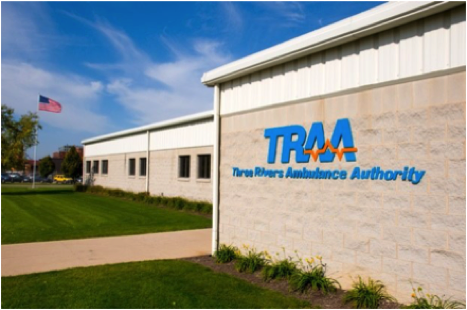
Name: Three Rivers Ambulance Authority (“TRAA”)
Founded: 1983
System Type: Governmental – Public Utility Model (PUM)
Primary Response Area: City of Fort Wayne, Indiana
Primary Response Area Size: 110 square miles
Primary Response Area Population: approx. 251,000
Secondary Response Area: Allen County, Indiana
Local Tax Subsidy: $0.00
TRAA is the City of Fort Wayne’s ambulance service. We provide all 911 emergency services and all non-emergency ambulance service to the citizens of Fort Wayne. We are not a private for-profit company, but are a not-for-profit unit of local government.
TRAA was created in 1983 by local ordinance adopted by the Fort Wayne City Council as a not-for-profit, governmental “authority” under Indiana law, to oversee and provide advanced life support (ALS) ambulance service to our community’s residents and visitors. The Commissioners of Allen County adopted TRAA as the county’s ALS service through adoption of an interlocal cooperative agreement.
TRAA receives no tax subsidy. We are required by ordinance to operate from fees charged for services provided. While there was an initial subsidy when the system was first started in 1983, we have remained tax subsidy free since 1986.
As a Public Utility Model, TRAA provides service through the use of a contractor for equipment and personnel to staff ambulances and our dispatch center. During the contract period, TRAA is the direct oversight agency of the contractor, assuring the contractor is compliant with items such as response time requirements, and other contractual obligations. To assure that the contractor continues to be efficient and fiscally responsible, TRAA periodically uses a contract procurement process to attract other entities to submit proposals to operate as TRAA’s Operations Division. This competitive procurement process assures that our community continues to receive excellence in care at a competitive price.
All of TRAA’s ambulances are staffed at the ALS-Paramedic level. This assures that every ambulance responding to any call is able to provide the highest level of prehospital care available in the State of Indiana. This staffing also creates efficiencies that actually help TRAA control costs since any ambulance can be used for any call, getting the most production possible from each resource.
TRAA’s rates are determined by TRAA’s Board of Directors. TRAA’s Board must review many items to decide the rates necessary for TRAA to remain solvent. Expenses such as equipment expenses, personnel expenses, fuel expenses, and maintenance expenses play a role in TRAA rates. Other factors that significantly affect TRAA’s rates are reimbursement “caps” imposed by federal healthcare programs like Medicare and Medicaid as well as the un-collectable amounts for those who simply cannot afford to pay for their healthcare services. TRAA’s rates must be sufficient to cover all of these expenses since TRAA receives no tax subsidy.
Even without any tax subsidy, TRAA’s rates are quite competitive and comparable to other area ALS-paramedic ambulance services in northeast Indiana. To see the most recent area rate survey, click here.
TRAA is accredited by the Commission on Accreditation of Ambulance Services. CAAS accreditation is a distinction reserved for only those ambulance services meeting the strictest standards designed to increase operational efficiency and clinical quality while reducing risk and liability to the organization. CAAS accreditation means that the ambulance service has met the “gold standard” for ambulance services nationwide.
TRAA’s communications center is an “ACE” accredited communications center. The Accredited Center of Excellence (ACE) accreditation is through the International Academies of Emergency Dispatch and signifies that TRAA’s dispatch center meets or exceeds the stringent national standards for maximizing efficiencies of communications centers and increasing patient outcomes by providing a consistent and effective method of emergency call intake with the provision of nationally accepted pre-arrival instructions to patients, families, and bystanders.